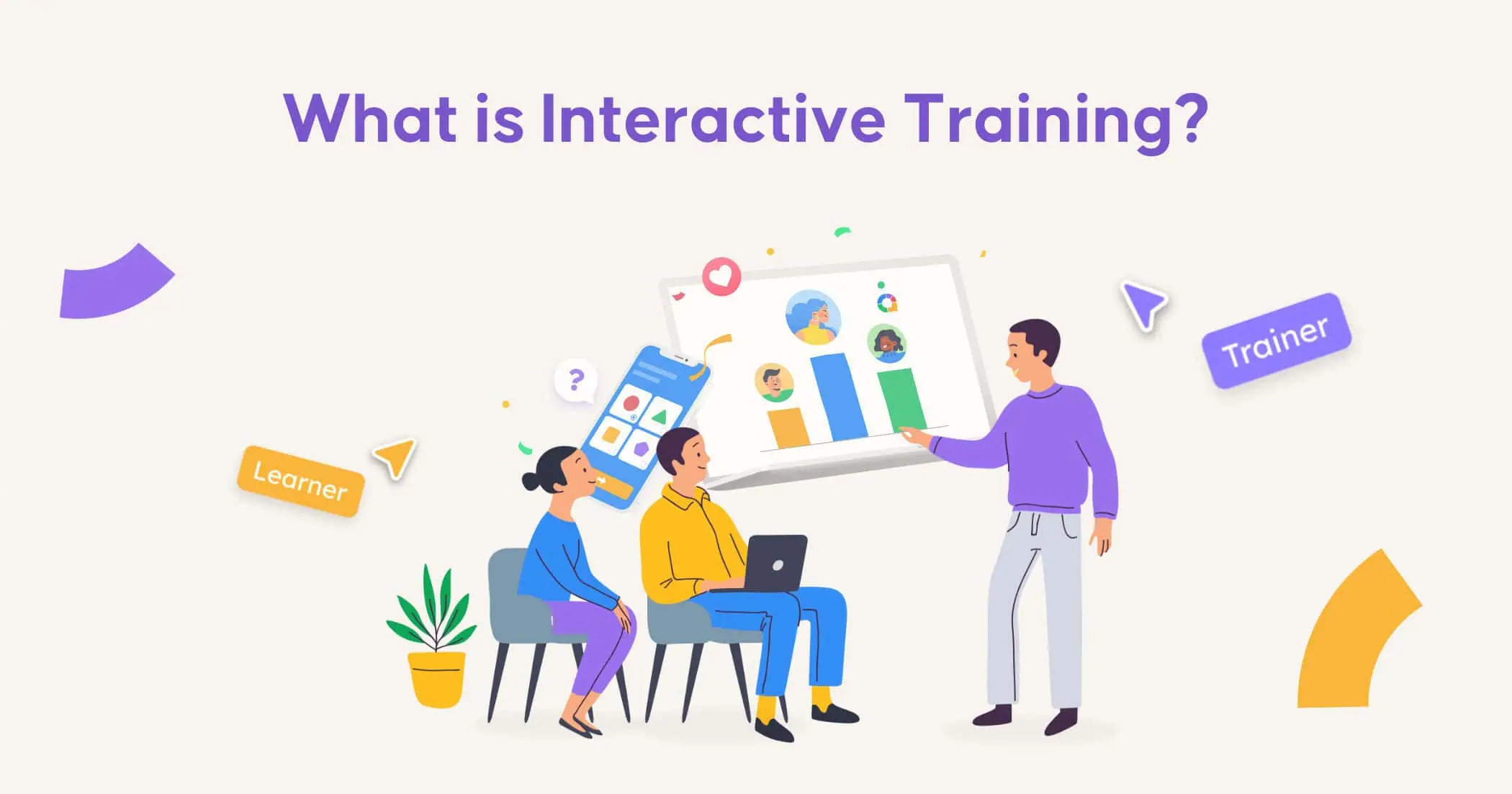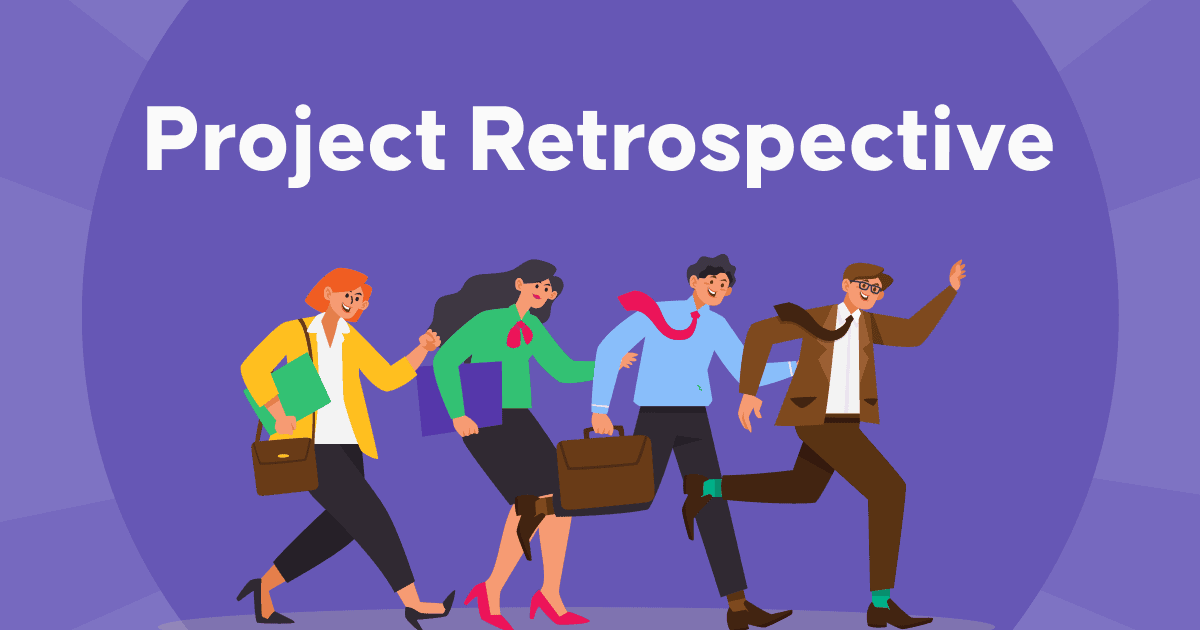Isi nke 0: Ụzọ Ọzụzụ Gị Ọ̀ Nọgidere?
Ị ka gụchara oge ọzụzụ ọzọ. Ị kesara ihe kacha mma gị. Ma ọ dị ihe dara.
Ọkara ụlọ ahụ nọ na-agagharị na ekwentị ha. Ọkara nke ọzọ nọ na-agbalị ka ọ ghara ugha.
I nwere ike ịnọ na-eche:
"Ọ bụ m? Ọ bụ ha? Ọ bụ ihe dị n'ime ya?"
Mana nke a bụ eziokwu:
Ọ dịghị nke ọ bụla n'ime ihe a bụ gị kpatara. Ma ọ bụ mmejọ nke ụmụ akwụkwọ gị.
Yabụ kedu ihe na-eme n'ezie?
Ụwa nke ọzụzụ na-agbanwe ngwa ngwa.
Mana, isi ihe gbasara mmụta mmadụ agbanwebeghị ma ọlị. Ma ebe ahụ ka ohere dị.
Chọrọ ịmata ihe ị nwere ike ime?
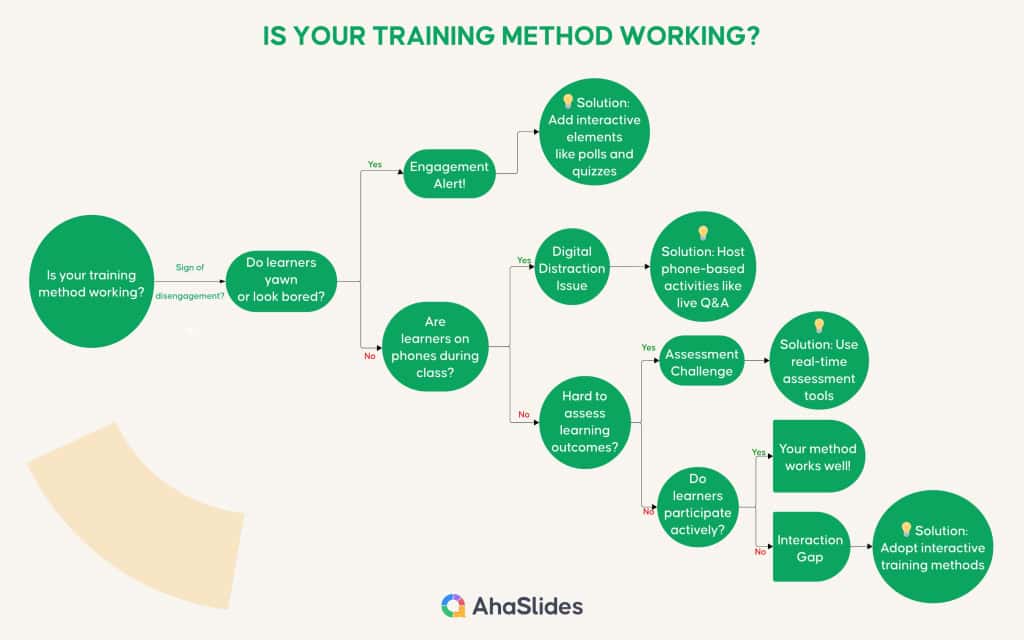
Ọ dịghị mkpa ka ị tụfuo usoro ọzụzụ gị niile. Ọdịghị mkpa ka ị gbanwee isi ọdịnaya gị.
Ihe ngwọta dị mfe karịa ka ị chere: mmekọrịta ọzụzụ.
Nke ahụ bụ kpọmkwem ihe anyị na-achọ ikpuchi na nke a blog post: Ndụmọdụ kacha mma maka ọzụzụ mmekọrịta ga-eme ka ụmụ akwụkwọ gị rapara n'okwu ọ bụla:
- Gịnị bụ Interactive Training?
- Mmekọrịta vs. Ọzụzụ Omenala - Gịnị kpatara na ọ bụ oge ịgbanwe
- Otu esi atụle ịga nke ọma Ọzụzụ (site na ọnụọgụ ọnụọgụgụ)
- Otu esi eme nnọkọ nkuzi mmekọrịta na AhaSlides
- Akụkọ ịga nke ọma Ọzụzụ mmekọrịta
Ị dịla njikere ime ka ọzụzụ gị ghara ileghara anya?
Ka anyị malite.
Tebulu ọdịnaya
Isi nke 1: Gịnị bụ Ọzụzụ mmekọrịta?
Gịnị bụ Interactive Training?
Ọzụzụ ọdịnala na-agwụ ike. Ị maara egwu egwu - mmadụ na-agwa gị okwu ruo ọtụtụ awa ka ị na-alụ ọgụ ka anya gị meghee.
Nke a bụ ihe:
Ọzụzụ mmekọrịta dị nnọọ iche.
Kedu?
Na ọzụzụ ọdịnala, ụmụ akwụkwọ na-anọdụ ala gee ntị. Na ọzụzụ mmekọrịta, kama ịrahụ ụra, ndị mmụta gị na-ekere òkè n'ezie. Ha na-aza ajụjụ. Ha na-asọ mpi n'ajụjụ ọnụ. Ha na-ekerịta echiche na ozugbo.
Nke bụ́ eziokwu bụ na mgbe ndị mmadụ na-ekere òkè, ha na-aṅa ntị. Mgbe ha na-aṅa ntị, ha na-echeta.
N'ikwu okwu n'ozuzu, ọzụzụ mmekọrịta bụ maka ime ka ndị mmụta tinye aka. Usoro ọgbara ọhụrụ a na-eme ka mmụta dịkwuo ụtọ ma dị irè.
Ihe m na-ekwu bụ:
- Ntuli aka dị ndụ nke onye ọ bụla nwere ike ịza site na ekwentị ha
- Ajụjụ ndị na-asọmpi
- Okwu igwe ojii na-ewuli onwe ha ka ndị mmadụ na-ekerịta echiche
- Oge ajụjụ & A ebe ọ nweghị onye na-atụ ụjọ ịjụ "ajụjụ ogbi"
- ...
Nke kacha mma?
Ọ na-arụ ọrụ n'ezie. Ka m gosi gị ihe kpatara ya.
Ihe kpatara ụbụrụ gị ji hụ ọzụzụ mmekọrịta mmekọrịta
Ụbụrụ gị dị ka akwara. Ọ na-esiwanye ike mgbe ị na-eji ya.
Chee echiche banyere nke a:
Eleghị anya ị na-echeta egwu egwu nke ọkacha mmasị gị na ụlọ akwụkwọ sekọndrị. Ma gịnị banyere ihe ngosi ahụ sitere na izu gara aga?
Nke ahụ bụ n'ihi na ụbụrụ gị na-echeta ihe nke ọma mgbe ị na-etinye aka na ya.
Na nyocha na-akwado nke a:
- Ndị mmadụ na-echeta 70% karịa mgbe ha na-eme ihe na-ege ntị naanị (Edgar Dale's Cone nke Ahụmahụ)
- Mmụta mmekọrịta na-akwalite ebe nchekwa site na 70% vs usoro ọdịnala. (Nnyocha na mmepe teknụzụ agụmakwụkwọ)
- 80% nke ndị ọrụ kwenyere na ọzụzụ mmekọrịta na-etinye aka karịa nkuzi ọdịnala (TalentLMS)
N'ikwu ya n'ụzọ ọzọ, mgbe ị na-ekere òkè na-arụsi ọrụ ike na mmụta, ụbụrụ gị na-abanye n'ike. Ọ bụghị naanị na ị na-anụ ozi - ị na-ahazi ya, na-eji ya ma na-echekwa ya.
3+ Bara uru Ọzụzụ mmekọrịta
Ka m gosi gị 3 nnukwu uru dị n'ịgbanwe na ọzụzụ mmekọrịta.
1. Mmekọrịta ka mma
The mmemme mmekọrịta mee ka ndị na-azụ ọzụzụ nwee mmasị na itinye uche.
N'ihi na ugbu a, ọ bụghị nanị na ha na-ege ntị - ha nọ na egwuregwu. Ha na-aza ajụjụ. Ha na-edozi nsogbu. Ha na ndị ọrụ ibe ha na-asọ mpi.
2. Ndogide dị elu
Ndị na-azụ ọzụzụ na-echetakwu ihe ha mụtara.
Ụbụrụ gị na-echeta naanị 20% nke ihe ị na-anụ, mana 90% nke ihe ị na-eme. Ọzụzụ mmekọrịta na-etinye ndị gị n'oche ọkwọ ụgbọ ala. Ha na-eme ihe. Ha na-ada. Ha na-aga nke ọma. Ma kacha mkpa? Ha na-echeta.
3. Afọ ojuju karịa
Ọzụzụ ahụ na-atọ ndị na-azụ ọzụzụ ụtọ karịa mgbe ha nwere ike isonye.
Ee, oge ọzụzụ na-agwụ ike adịghị mma. Ma mee ka ọ na-emekọrịta ihe? Ihe niile na-agbanwe. Enweghị ihu ụra ọzọ ma ọ bụ ekwentị zoro ezo n'okpuru tebụl - ndị otu gị na-enwe obi ụtọ maka nnọkọ ahụ.
Inweta uru ndị a abụghị sayensị rọketi. Naanị ị chọrọ ngwaọrụ kwesịrị ekwesị nwere njirimara kwesịrị ekwesị.
Ma olee otu ị ga-esi mara nke kacha mma maka ọzụzụ mmekọrịta?
Atụmatụ 5+ isi nke Ngwa nkuzi mmekọrịta
Nke a dị nzuzu:
Ngwá ọrụ ọzụzụ mmekọrịta kacha mma adịghị mgbagwoju anya. Ha anwụọla mfe.
Yabụ, kedu ihe na-eme ka ọ bụrụ nnukwu akụrụngwa ọzụzụ mmekọrịta?
Nke a bụ ụfọdụ isi atụmatụ dị mkpa:
- Ajuju oge: Nyochaa ihe ọmụma ndị na-ege ntị ozugbo.
- Ntuli aka dị ndụ: Ka ndị mmụta kesaa echiche na echiche ha ozugbo site na ekwentị ha.
- Okwu igwe ojii: Na-achịkọta echiche onye ọ bụla n'otu ebe.
- Obi ike: Na-enye ndị mmụta ohere ịkparịta ụka na dozie nsogbu ọnụ.
- Q&A sessions: Ndị na-amụ ihe nwere ike ịza ajụjụ ha, ọ dịghị mkpa iwelite aka.

Ugbu a:
Atụmatụ ndị a dị mma. Ma a na m anụ ihe ị na-eche: Kedu ka ha si akwado usoro ọzụzụ ọdịnala?
Nke ahụ bụ kpọmkwem ihe na-abịa n'ihu.
Isi nke 2: Mmekọrịta vs. Ọzụzụ Omenala - Gịnị kpatara na ọ bụ oge ịgbanwe
Mmekọrịta vs Ọzụzụ Omenala
Nke a bụ eziokwu: Ọzụzụ ọdịnala na-anwụ. Na enwere data iji gosi ya.
Ka m gosi gị kpọmkwem ihe kpatara ya:
| Ihe | Ọzụzụ ọdịnala | Ọzụzụ mmekọrịta |
|---|---|---|
| njikọ aka | 😴 Ndị mmadụ na-apụ mgbe nkeji iri gachara | 🔥 85% na-arụ ọrụ oge niile |
| Njide | 📉 5% cheta mgbe awa 24 gachara | 📈 75% cheta mgbe otu izu gachara |
| Soro | 🤚 Naanị ndị oké ụda na-ekwu okwu | ✨ Onye ọ bụla na-esonye (na-amaghị aha!) |
| nzaghachi | ⏰ Chere ruo ule ikpeazụ | ⚡ Nweta nzaghachi ozugbo |
| Mgbu | 🐌 Otu ijeụkwụ maka onye ọ bụla | 🏃♀️ Na-adaba maka ọsọ onye mmụta |
| content | 📚 Ogologo nkuzi | 🎮 Mpekere dị mkpụmkpụ, na-emekọrịta ihe |
| Ngwaọrụ | 📝 Mpempe akwụkwọ | 📱 Digital, enyi na enyi |
| Assessment | 📋 Nnwale ngwụcha | 🎯 Nyocha ihe ọmụma nke oge |
| ajụjụ | 😰 na-atụ ụjọ ịjụ ajụjụ "ogbi". | 💬 Ajụjụ&A na-amaghị aha mgbe ọ bụla |
| -eri | 💰 Ọnụ ego obibi akwụkwọ na ebe mgbakọ | 💻 Ọnụ ego dị ala, nsonaazụ kacha mma |
Olee otú Social Media si gbanwee ọzụzụ ruo mgbe ebighị ebi (na ihe a ga-eme)
Ka anyị chee ya ihu: Ụbụrụ ụmụ akwụkwọ gị agbanweela.
N'ihi gịnị?
Nke a bụ ihe ndị mmụta taa na-eji:
- Vidiyo TikTok: 15-60 sekọnd
- 📱 Instagram Reels: n'okpuru 90 sekọnd
- 🎯 YouTube Shorts: 60 sekọnd kacha
- 💬 Twitter: mkpụrụedemede 280
Tulee ya na:
- 📚 Ọzụzụ ọdịnala: Oge nkeji iri isii
- 🥱 PowerPoint: ihe ngosi 30+
- 😴 nkuzi: Oge awa okwu
Hụ nsogbu ahụ?
Ka TikTok siri gbanwee ka anyị si amụta...
Ka anyi kwatuo:
1. Nlebara anya agbanweela
Ụbọchị ochie:
- Nwere ike itinye uche maka nkeji 20+.
- Gụọ ogologo akwụkwọ.
- Nọdụ ala site na nkuzi.
Ugbu a:
- Ogologo nlebara anya nke 8-nkeji.
- Nyochaa kama ịgụ ihe.
- Achọrọ mkpali mgbe niile
2. Atụrụ anya ọdịnaya dị iche
Ụbọchị ochie:
- Ogologo nkuzi.
- Mgbidi nke ederede.
- Ihe nkiri slide na-agwụ ike.
Ugbu a:
- Ngwa ngwa akụ.
- Ọdịnaya anya.
- Mobile-mbụ.
3. Mmekọrịta bụ ihe ọhụrụ nkịtị
Ụbọchị ochie:
- Ị na-ekwu okwu. Ha na-ege ntị.
Ugbu a:
- Mmekọrịta ụzọ abụọ. Onye ọ bụla na-etinye aka.
- Nzaghachi ozugbo.
- Ihe ndị na-elekọta mmadụ.
Nke a bụ tebụl na-akọ akụkọ ahụ dum. Lee anya:
| Atụmanya ochie | Atụmanya ọhụrụ |
|---|---|
| Nọdụ ala gee ntị | Mmekọrịta ma tinye aka |
| Chere nzaghachi | Nzaghachi ozugbo |
| Soro usoro ihe omume | Mụta ihe n'ụzọ ha si dị |
| Okwu nkuzi otu ụzọ | Mkparịta ụka ụzọ abụọ |
| Otu ọdịnaya maka mmadụ niile | Ọmụmụ ahaziri onwe ya |
Otu esi eme ka ọzụzụ gị rụọ ọrụ taa (Echiche ise)
Ihe m chọrọ ikwu bụ: Ị na-eme ihe karịrị nanị izi ihe. Ị na-asọmpi TikTok na Instagram - ngwa emebere ka ọ na-eri ahụ. Ma nke a bụ ozi ọma: Ịchọghị aghụghọ. Naanị ị chọrọ imewe smart. Nke a bụ echiche ọzụzụ mmekọrịta dị ike 5 ị kwesịrị ịnwale ma ọ dịkarịa ala otu ugboro ( tụkwasị m obi na ndị a):
Jiri ntuli aka ngwa ngwa
Ka m doo anya: Ọ dịghị ihe na-egbu nnọkọ ọsọ ọsọ karịa nkuzi otu ụzọ. Ma tụba n'ime ntuli aka ngwa ngwa? Lelee ihe na-eme. Ekwentị ọ bụla dị n'ime ụlọ ga-elekwasị anya na ọdịnaya gị. Dịka ọmụmaatụ, ị nwere ike ịhapụ ntuli aka kwa nkeji iri ọ bụla. Tụkwasa m obi - ọ na-arụ ọrụ. Ị ga-enweta nzaghachi ozugbo na ihe na-agbada na ihe chọrọ ịrụ ọrụ.

Jiri ajụjụ mkparịta ụka mee egwuregwu
Ajuju oge niile na-eme ka mmadụ hie ụra. Ma mkparịta ụka ajụjụ ya na bọọdụ ndu? Ha nwere ike ime ụlọ ahụ ọkụ. Ndị sonyere gị anaghị aza naanị - ha na-asọ mpi. Ha na-enweta nko. Na mgbe ndị mmadụ na-nkọ, na-amụta osisi.

Gbanwee ajụjụ ka ọ bụrụ mkparịta ụka
Nke bụ eziokwu bụ na 90% nke ndị na-ege gị ntị nwere ajụjụ, mana ọtụtụ agaghị eweli aka ha. Ngwọta? Mepee a Nnọkọ ajụjụ&A dị ndụ ma mee ka ọ ghara ịma. BOOM. Lelee ajụjụ na-ejupụta dị ka okwu Instagram. Ndị sonyere n'udo ndị na-adịghị ekwu okwu ga-abụ ndị na-enye aka na-arụkọ ọrụ ọnụ.

Jiri anya nke uche hụ echiche otu
Ịchọrọ 10x oge izu ike gị? Mwepụta a igwe okwu. Ka onye ọ bụla tụba echiche n'otu oge. Okwu igwe ojii ga-atụgharị echiche enweghị usoro ka ọ bụrụ ọmarịcha ọhụụ nke echiche mkpokọta. N'adịghịkwa ka ntugharị uche ọdịnala ebe ụda kachasị na-emeri, onye ọ bụla na-enweta ntinye nha anya.
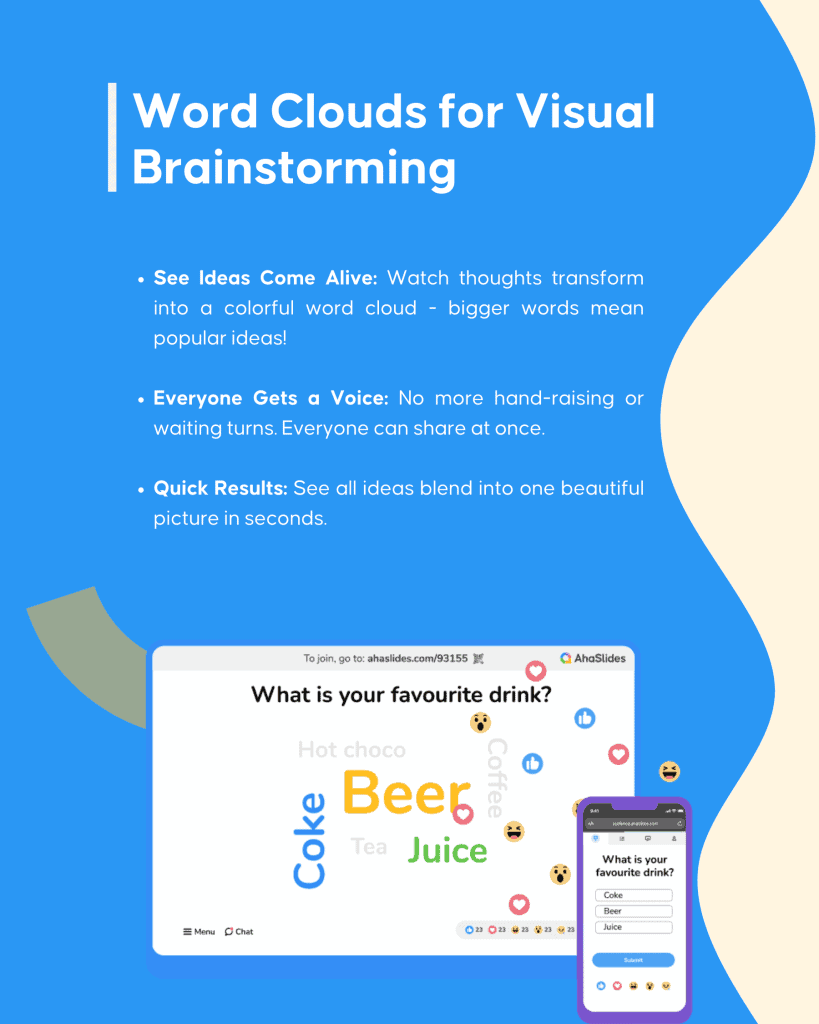
Jiri wheel spinner tinye ihe ọchị na-enweghị usoro
Ịgba nkịtị nwụrụ anwụ bụ nrọ nke onye nkuzi ọ bụla. Mana nke a bụ aghụghọ na-arụ ọrụ oge ọ bụla: Spinner wheel.
Jiri nke a mgbe ị hụrụ nlebara anya na-adaba. Otu tụgharịa na onye ọ bụla na-azụ na egwuregwu.
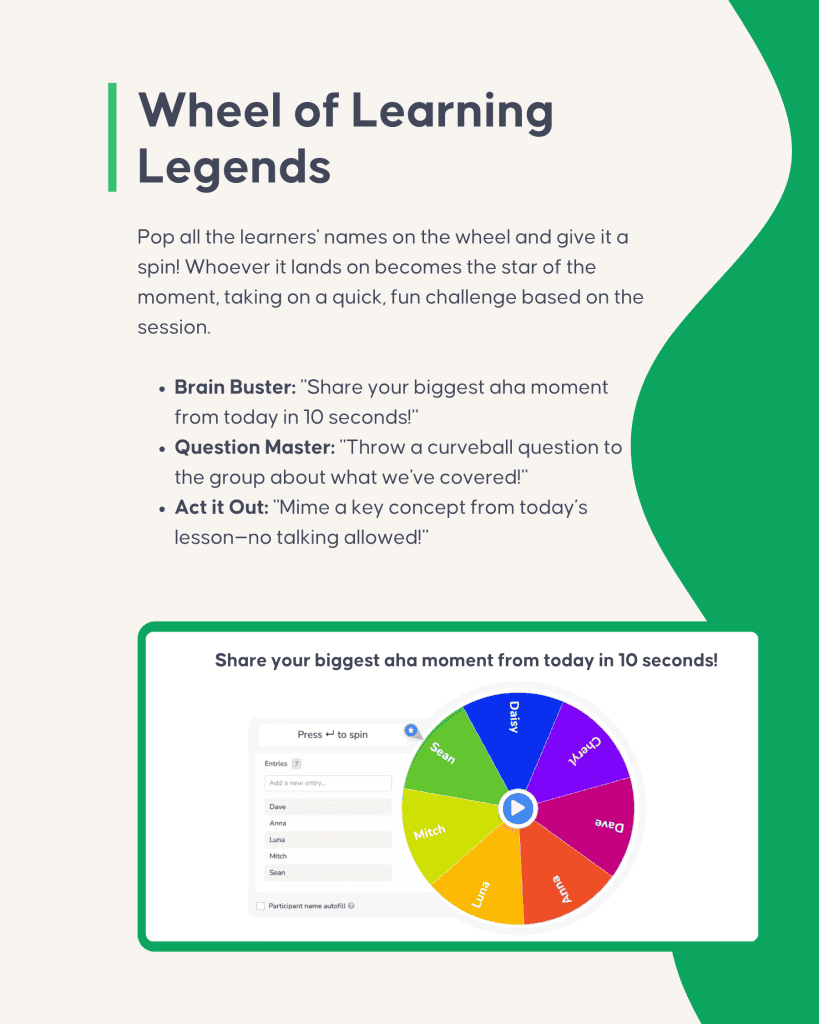
Ugbu a ịmara ka esi kwalite ọzụzụ gị, enwere naanị otu ajụjụ fọdụrụ:
Kedu ka ị si mara na ọ bụ na-arụ ọrụ n'ezie?
Ka anyị leba anya na ọnụọgụgụ.
Isi nke 3: Otu esi amata Ọganihu Ọzụzụ n'ezie (site na ọnụọgụ ọnụọgụgụ)
Chezọ metric efu. Nke a bụ ihe na-egosi n'ezie ma ọ bụrụ na ọzụzụ gị na-arụ ọrụ:
Naanị Metrics 5 dị mkpa
Nke mbụ, ka anyị doo anya:
Naanị ịgụ isi n'ime ụlọ anaghị ebipụ ya ọzọ. Nke a bụ ihe dị mkpa iji soro ma ọ bụrụ na ọzụzụ gị na-arụ ọrụ:
1. Njikọ aka
Nke a bụ nnukwu.
Chee echiche banyere ya: Ọ bụrụ na ndị mmadụ na-emekọrịta ihe, ha na-amụ ihe. Ọ bụrụ na ha anọghị, ha nwere ike ịnọ na TikTok.
Soro ndị a:
- Mmadụ ole na-aza ntuli aka/ajụjụ (echere 80%+)
- Onye na-ajụ ajụjụ (karịa = mma)
- Onye na-esonyere mmemme (kwesịrị ịbawanye ka oge na-aga)
2. Nyocha ihe ọmụma
Dị mfe ma dị ike.
Gbaa ajụjụ ngwa ngwa:
- Tupu ọzụzụ (ihe ha maara)
- N'oge ọzụzụ (ihe ha na-amụta)
- Mgbe ọzụzụ gasịrị (ihe rapaara)
Ihe dị iche na-agwa gị ma ọ na-arụ ọrụ.
3. Ọnụ ahịa mmecha
Ee, isi. Ma ọ dị mkpa.
Ọzụzụ dị mma na-ahụ:
- 85%+ ọnụego mmecha
- Ihe na-erughị 10% nkwụsị
- Ọtụtụ ndị mmadụ na-emecha n'isi
4. Nghọta ọkwa
Ị nweghị ike ịhụ nsonaazụ echi. Mana ị ga-ahụ ma ndị mmadụ ga-enweta ya site na iji Q&As na-amaghị aha. Ha bụ ọla edo maka ịchọta ihe ndị mmadụ ghọtara (ma ọ bụ na-aghọtaghị).
Mgbe ahụ, soro ndị a:
- Nzaghachi mepere emepe nke na-egosi ezi nghọta
- Ajụjụ na-esochi na-ekpughe nghọta miri emi
- Mkparịta ụka otu ebe ndị mmadụ na-ewulite n'echiche ibe ha
5. Akara afọ ojuju
Ndị mmụta nwere obi ụtọ = nsonaazụ kacha mma.
Ị ga-achọ ebumnuche:
- 8+ n'ime 10 afọ ojuju
- "Ọ ga-akwado" nzaghachi
- Okwu ziri ezi
Kedu ka AhaSlides si eme ka nke a dị mfe
Ọ bụ ezie na ngwaọrụ ọzụzụ ndị ọzọ na-enyere gị aka ịme slide, AhaSlides nwekwara ike igosi gị kpọmkwem ihe na-arụ ọrụ. Otu ngwá ọrụ. Ugboro abụọ mmetụta.
Kedu? Nke a bụ ụzọ AhaSlides si agbaso ihe ịga nke ọma ọzụzụ gị:
| Ihe ị chọrọ | Kedu ka AhaSlides si enyere aka |
|---|---|
| 🎯 Mepụta ọzụzụ mmekọrịta | ✅ ntuli aka na ajụjụ ọnụ ✅ Okwu igwe ojii na oke egwu ✅ Asọmpi otu ✅ Oge ajụjụ na azịza ✅ Nzaghachi ozugbo |
| 📈 Real-time nsuso | Nweta nọmba na: ✅ Onye sonye ✅ Ihe ha zara ✅ Ebe ha gbara mgba |
| 💬 Nzaghachi dị mfe | Nweta nzaghachi site na: ✅ Ntuli aka ngwa ngwa ✅ Ajụjụ amaghị ✅ Mmeghachi omume ndụ |
| 🔍 Smart analytics | Sochie ihe niile na-akpaghị aka: ✅ Ngụkọta ndị sonyere ✅ Akara ajụjụ ✅ Nkeji nrubeisi ✅ Ngosipụta |
Yabụ AhaSlides na-enyocha ihe ịga nke ọma gị. Akwa.
Mana nke mbụ, ị ga-achọ ọzụzụ mmekọrịta kwesịrị ịdị nha.
Chọrọ ịhụ ka esi emepụta ya?
Isi nke 4: Otu esi eme Mkpakọrịta Ọzụzụ na AhaSlides (Ntuziaka nzọụkwụ site na nzọụkwụ)
Ozizi zuru oke. Ka anyị nweta ihe bara uru.
Ka m gosi gị otu esi eme ka ọzụzụ gị na AhaSlides na-etinyekwu aka (ọ ga-enwerịrị usoro ọzụzụ mmekọrịta gị).
Nzọụkwụ 1: Hazie
Nke a bụ ihe ị ga-eme:
- Isi na AhaSlides.com
- Pịa "Debanye aha n'efu"
- Mepụta ihe ngosi izizi gị
Nke ahụ bụ ya, n'ezie.
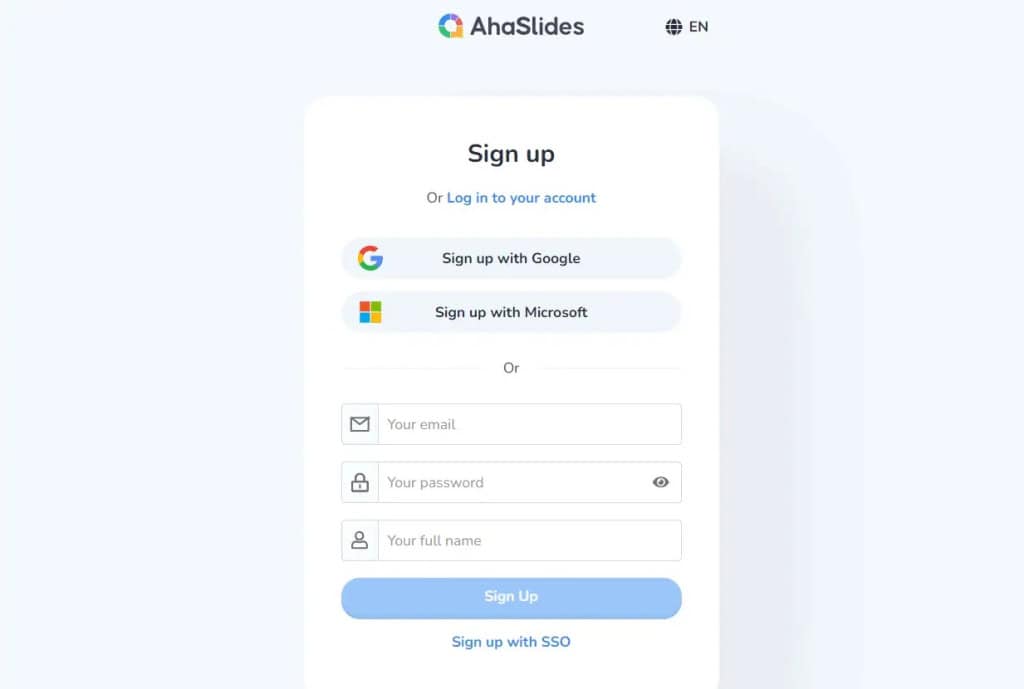
Nzọụkwụ 2: Tinye ihe mmekọrịta
Naanị pịa "+" wee họrọ nke ọ bụla n'ime ndị a:
- Ajuju: Jiri akara akara akpaaka na bọọdụ ndị isi mee mmụta ihe ọchị
- Ntuli aka: Chịkọta echiche na nghọta ozugbo
- Okwu igwe ojii: Mepụta echiche ọnụ na okwu igwe ojii
- Ajụjụ&A dị ndụ: Kwaa ajụjụ na mkparịta ụka mepere emepe
- Wheel Wheel: Tinye ihe ịtụnanya ka ịmekọrịta nnọkọ
Nzọụkwụ 3: Jiri ihe ochie gị?
Ị nwere ọdịnaya ochie? Nsogbu adịghị.
Bubata PowerPoint
Ị nwere PowerPoint? Zuru oke.
Nke a bụ ihe ị ga-eme:
- Pịa "Bubata PowerPoint"
- Wepu faịlụ gị
- Tinye ihe mmịfe na-emekọrịta ihe n'etiti nke gị
Mere.
Ọ ka mma? Ị nwere ike jiri AhaSlides ozugbo na PowerPoint site na iji mgbakwunye anyị!
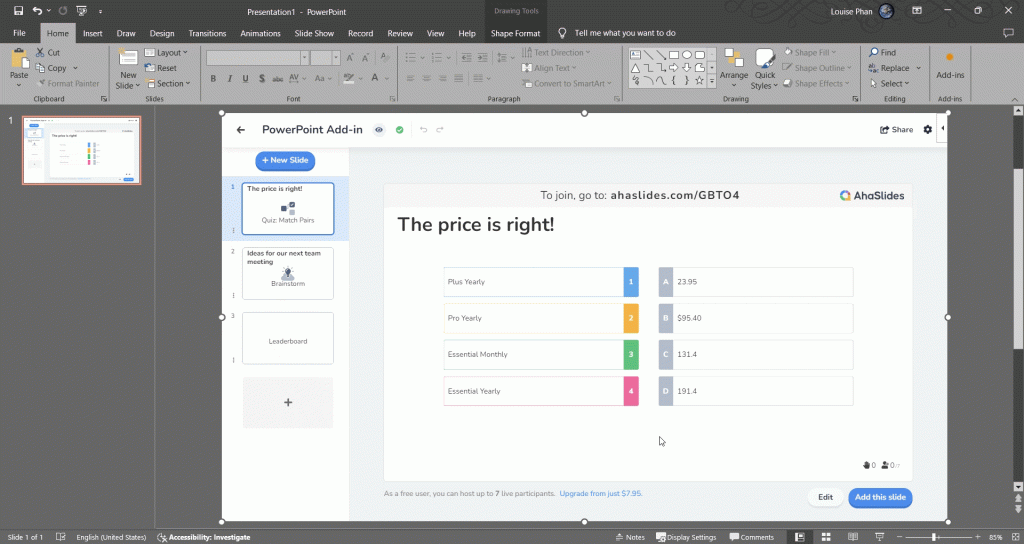
Ihe mgbakwunye Platform
iji Microsoft Teams or Mbugharị maka nzukọ? AhaSlides na-arụ ọrụ n'ime ha yana mgbakwunye mgbakwunye! Enweghị mwụli elu n'etiti ngwa. Enweghị nsogbu.
Nzọụkwụ 4: Oge ngosi
Ugbu a ị dịla njikere iweta.
- Pịa "Ugbu a"
- Kekọrịta koodu QR
- Lelee ndị mmadụ na-esonye
Dị mfe.
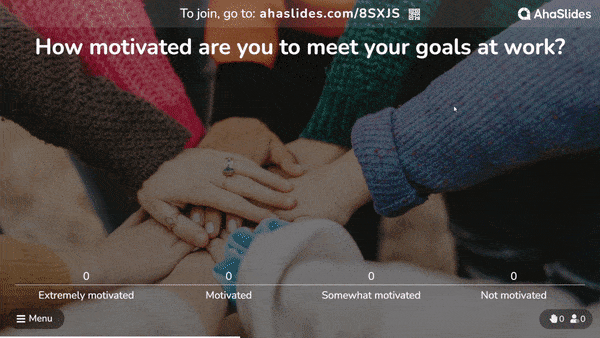
Ka m mee ka nke a doo anya:
Nke a bụ kpọmkwem ka ndị na-ege gị ntị ga-esi na-emekọrịta ihe na slides gị (Ị ga-ahụ ka nke a dị mfe). 👇
(Ị ga-amasị gị ka nke a dị mfe)

Isi nke 5: Akụkọ ịga nke ọma Ọzụzụ Mmekọrịta (Ndị Na-arụ ọrụ n'ezie)
Nnukwu ụlọ ọrụ na-ahụtala nnukwu mmeri na ọzụzụ mmekọrịta. Enwere ụfọdụ akụkọ na-aga nke ọma nke nwere ike ime ka ị maa mma:
AstraZeneca
Otu n'ime ihe atụ ọzụzụ mmekọrịta kacha mma bụ akụkọ AstraZeneca. Nnukwu ọgwụ mba ụwa AstraZeneca chọrọ ịzụ ndị na-ere ahịa 500 na ọgwụ ọhụrụ. Ya mere, ha tụgharịrị ọzụzụ ịzụ ahịa ha ka ọ bụrụ egwuregwu afọ ofufo. Enweghị mmanye. Enweghị ihe achọrọ. Naanị asọmpi otu, ụgwọ ọrụ na bọọdụ ndị isi. Gịnị si na ya pụta? 97% nke ndị nnọchi anya sonyere na. 95% gwụchara nnọkọ ọ bụla. Ma nweta nke a: ọtụtụ egwuri egwu n'èzí awa ọrụ. Otu egwuregwu mere ihe atọ: wuo otu egwuregwu, kụziere nkà, ma kpalie ndị na-ere ahịa ọkụ.
Deloitte
Na 2008, Deloitte hiwere Deloitte Leadership Academy (DLA) dị ka mmemme ọzụzụ ime n'ịntanetị, ha wee mee mgbanwe dị mfe. Kama naanị ọzụzụ, Deloitte ji ụkpụrụ gamification mee ihe iji kwalite ntinye aka na nsonye mgbe niile. Ndị ọrụ nwere ike ịkekọrịta ihe ha rụzuru na LinkedIn, na-akwalite aha ọha nke ndị ọrụ n'otu n'otu. Ịmụta ghọrọ ụlọ ọrụ. Nsonaazụ pụtara doro anya: njikọ aka bilitere 37%. Dị irè, ha wuru Mahadum Deloitte iji weta usoro a n'ime ụwa n'ezie.
The National Technical University nke Athens
The National Technical University nke Athens gbara nnwale ya na ụmụ akwụkwọ 365. Nkuzi ọdịnala vs mmụta mmekọrịta.
Ihe dị iche?
- Ụzọ mmekọrịta kwalitere arụmọrụ site na 89.45%
- N'ozuzu arụmọrụ ụmụ akwụkwọ gbagoro 34.75%
Nchọpụta ha na-egosi na mgbe ị tụgharịrị ọnụ ọgụgụ ka ọ bụrụ usoro ịma aka na mmemme mmekọrịta, mmụta na-akawanye mma.
Ndị ahụ bụ nnukwu ụlọ ọrụ na mahadum. Ma gịnị banyere ndị na-enye ọzụzụ kwa ụbọchị?
Nke a bụ ụfọdụ ndị nkuzi tụgharịrị gaa na usoro mmekọrịta site na iji AhaSlides na nsonaazụ ha…
Akaebe ndị nkuzi

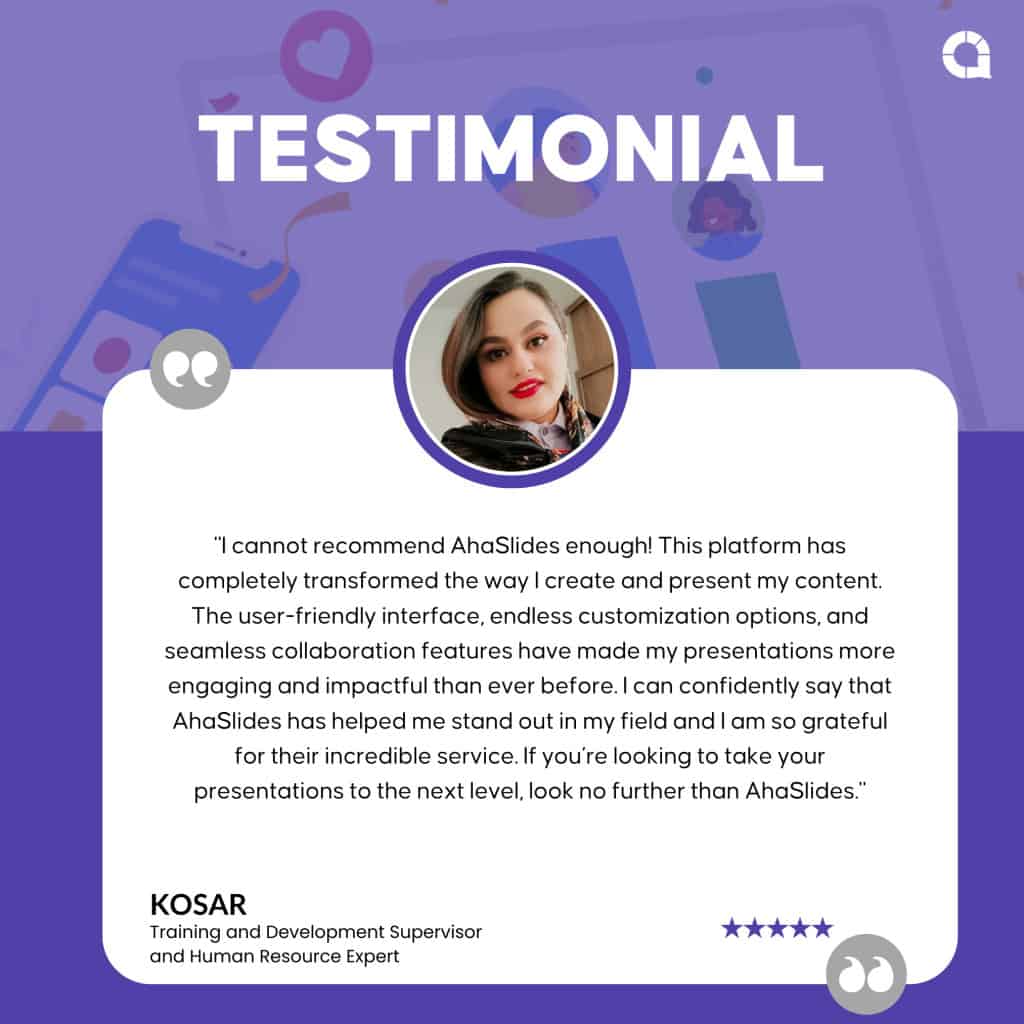

mmechi
Yabụ, nke ahụ bụ ntuziaka m maka ọzụzụ mmekọrịta.
Tupu anyị asị nke ọma, ka m dokwuo anya maka otu ihe:
Ọzụzụ mmekọrịta na-arụ ọrụ. Ọ bụghị n'ihi na ọ dị ọhụrụ. Ọ bụghị n'ihi na ọ bụ trendy. Ọ na-arụ ọrụ n'ihi na ọ dabara ka anyị si amụta ihe.
Na mmegharị gị ọzọ?
Ịchọghị ịzụta ngwá ọrụ ọzụzụ dị oke ọnụ, wughachi ọzụzụ gị niile ma ọ bụ bụrụ ọkachamara ntụrụndụ. N'ezie, ị naghị eme ya.
Echela nke a.
Naanị ị chọrọ:
- Tinye otu mmekọ na nnọkọ gị ọzọ
- Lelee ihe na-arụ ọrụ
- Meekwuo nke ahụ
Nke ahụ bụ naanị ihe ị ga-elekwasị anya.
Mee mmekọrịta gị na ndabara, ọ bụghị nke gị. Nsonaazụ ga-ekwu maka onwe ha.
